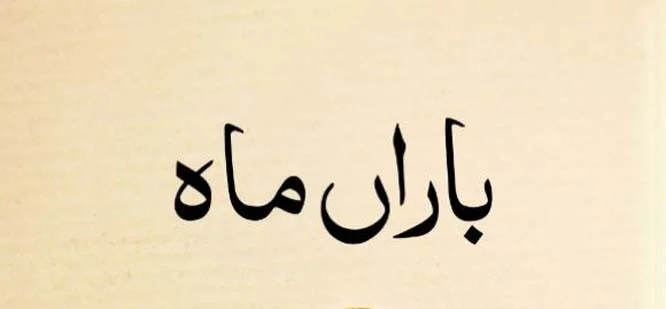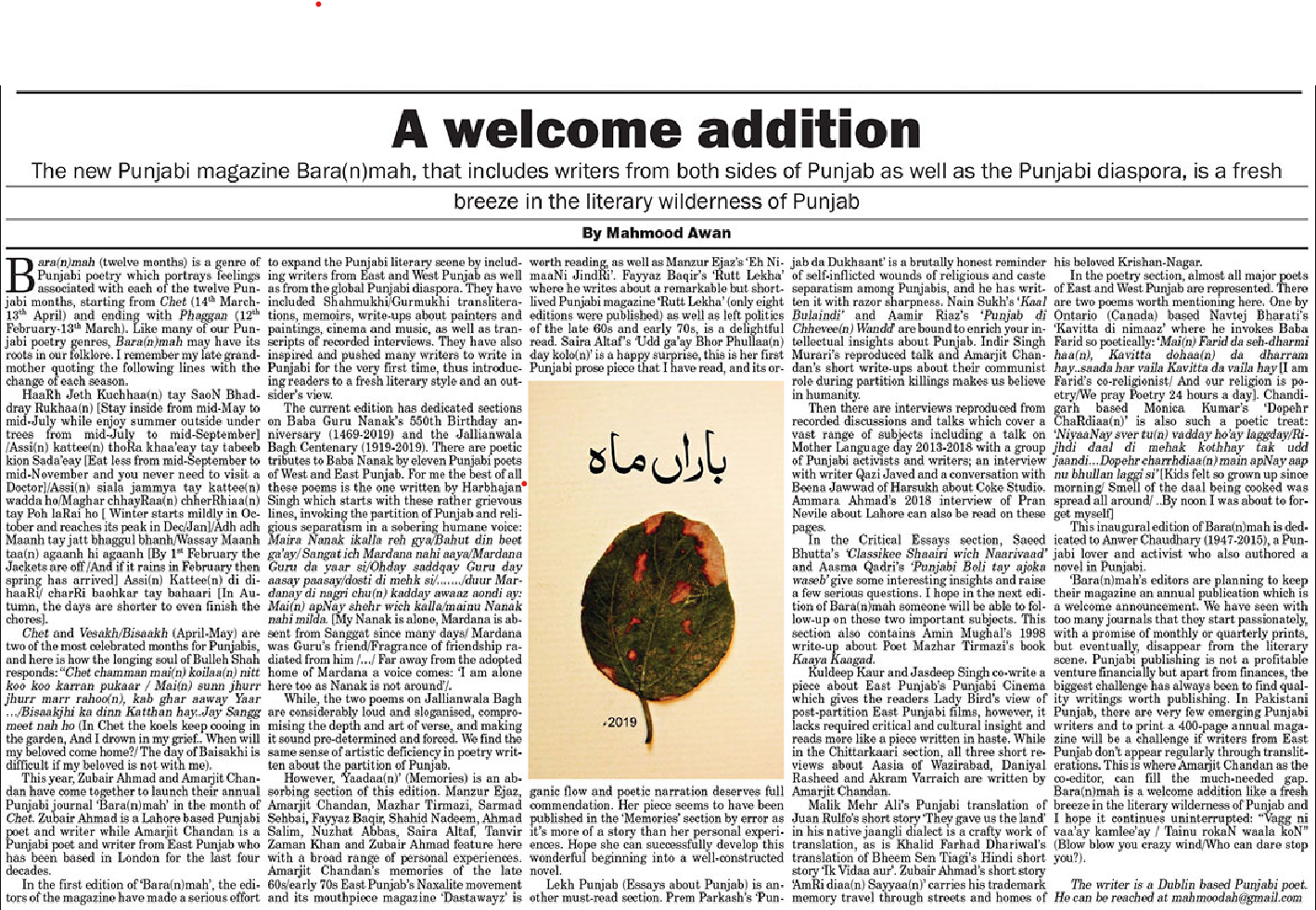Mahmood Awan (The News on Sunday, 5th May 2019)
Bara(n)mah (twelve months) is a genre of Punjabi poetry which portrays feelings associated with each of the twelve Punjabi months, starting from Chet (14th March-13th April) and ending with Phaggan (12th February-13th March). Like many of our Punjabi poetry genres, Bara(n)mah may have its roots in our folklore. I remember my late grandmother quoting the following lines with the change of each season.
HaaRh Jeth Kuchhaa(n) tay SaoN Bhaddray Rukhaa(n) [Stay inside from mid-May to mid-July while enjoy summer outside under trees from mid-July to mid-September] /Assi(n) kattee(n) thoRa khaa’eay tay tabeeb kion Sada’eay [Eat less from mid-September to mid-November and you never need to visit a Doctor]/Assi(n) siala jammya tay kattee(n) wadda ho/Maghar chhayRaa(n) chherRhiaa(n) tay Poh laRai ho [ Winter starts mildly in October and reaches its peak in Dec/Jan]/Adh adh Maanh tay jatt bhaggul bhanh/Wassay Maanh taa(n) agaanh hi agaanh [By 1st February the Jackets are off /And if it rains in February then spring has arrived] Assi(n) Kattee(n) di dihaaRi/ charRi baohkar tay bahaari [In Autumn, the days are shorter to even finish the chores].
Chet and Vesakh/Bisaakh (April-May) are two of the most celebrated months for Punjabis, and here is how the longing soul of Bulleh Shah responds: “Chet chamman mai(n) koilaa(n) nitt koo koo karran pukaar / Mai(n) sunn jhurr jhurr marr rahoo(n), kab ghar aaway Yaar …/Bisaakjhi ka dinn Katthan hay..Jay Sangg meet nah ho (In Chet the koels keep cooing in the garden, And I drown in my grief.. When will my beloved come home?/ The day of Baisakhi is difficult if my beloved is not with me).
This year, Zubair Ahmad and Amarjit Chandan have come together to launch their annual Punjabi journal ‘Bara(n)mah’ in the month of Chet. Zubair Ahmad is a Lahore based Punjabi poet and writer while Amarjit Chandan is a Punjabi poet and writer from East Punjab who has been based in London for the last four decades.
In the first edition of ‘Bara(n)mah’, the editors of the magazine have made a serious effort to expand the Punjabi literary scene by including writers from East and West Punjab as well as from the global Punjabi diaspora. They have included Shahmukhi/Gurmukhi transliterations, memoirs, write-ups about painters and paintings, cinema and music, as well as transcripts of recorded interviews. They have also inspired and pushed many writers to write in Punjabi for the very first time, thus introducing readers to a fresh literary style and an outsider’s view.
The current edition has dedicated sections on Baba Guru Nanak’s 550th Birthday anniversary (1469-2019) and the Jallianwala Bagh Centenary (1919-2019). There are poetic tributes to Baba Nanak by eleven Punjabi poets of West and East Punjab. For me the best of all these poems is the one written by Harbhajan Singh which starts with these rather grievous lines, invoking the partition of Punjab and religious separatism in a sobering humane voice: Maira Nanak ikalla reh gya/Bahut din beet ga’ay/ Sangat ich Mardana nahi aaya/Mardana Guru da yaar si/Ohday saddqay Guru day aasay paasay/dosti di mehk si/..…../duur Mardanay di nagri chu(n) kadday awaaz aondi ay: Mai(n) apNay shehr wich kalla/mainu Nanak nahi milda. [My Nanak is alone, Mardana is absent from Sanggat since many days/ Mardana was Guru’s friend/Fragrance of friendship radiated from him /…/ Far away from the adopted home of Mardana a voice comes: ‘I am alone here too as Nanak is not around’/.
While, the two poems on Jallianwala Bagh are considerably loud and sloganised, compromising the depth and art of verse, and making it sound pre-determined and forced. We find the same sense of artistic deficiency in poetry written about the partition of Punjab.
However, ‘Yaadaa(n)’ (Memories) is an absorbing section of this edition. Manzur Ejaz, Amarjit Chandan, Mazhar Tirmazi, Sarmad Sehbai, Fayyaz Baqir, Shahid Nadeem, Ahmad Salim, Nuzhat Abbas, Saira Altaf, Tanvir Zaman Khan and Zubair Ahmad feature here with a broad range of personal experiences. Amarjit Chandan’s memories of the late 60s/early 70s East Punjab’s Naxalite movement and its mouthpiece magazine ‘Dastawayz’ is worth reading, as well as Manzur Ejaz’s ‘Eh NimaaNi JindRi’. Fayyaz Baqir’s ‘Rutt Lekha’ where he writes about a remarkable but short-lived Punjabi magazine ‘Rutt Lekha’ (only eight editions were published) as well as left politics of the late 60s and early 70s, is a delightful read. Saira Altaf’s ‘Udd ga’ay Bhor Phullaa(n) day kolo(n)’ is a happy surprise, this is her first Punjabi prose piece that I have read, and its organic flow and poetic narration deserves full commendation. Her piece seems to have been published in the ‘Memories’ section by error as it’s more of a story than her personal experiences. Hope she can successfully develop this wonderful beginning into a well-constructed novel.
Lekh Punjab (Essays about Punjab) is another must-read section. Prem Parkash’s ‘Punjab da Dukhaant’ is a brutally honest reminder of self-inflicted wounds of religious and caste separatism among Punjabis, and he has written it with razor sharpness. Nain Sukh’s ‘Kaal Bulaindi’ and Aamir Riaz’s ‘Punjab di Chhevee(n) Wandd’ are bound to enrich your intellectual insights about Punjab. Indir Singh Murari’s reproduced talk and Amarjit Chandan’s short write-ups about their communist role during partition killings makes us believe in humanity.
Then there are interviews reproduced from recorded discussions and talks which cover a vast range of subjects including a talk on Mother Language day 2013-2018 with a group of Punjabi activists and writers; an interview with writer Qazi Javed and a conversation with Beena Jawwad of Harsukh about Coke Studio. Ammara Ahmad’s 2018 interview of Pran Nevile about Lahore can also be read on these pages.
In the Critical Essays section, Saeed Bhutta’s ‘Classikee Shaairi wich Naarivaad’ and Aasma Qadri’s ‘Punjabi Boli tay ajoka waseb’ give some interesting insights and raise a few serious questions. I hope in the next edition of Bara(n)mah someone will be able to follow-up on these two important subjects. This section also contains Amin Mughal’s 1998 write-up about Poet Mazhar Tirmazi’s book Kaaya Kaagad.
Kuldeep Kaur and Jasdeep Singh co-write a piece about East Punjab’s Punjabi Cinema which gives the readers Lady Bird’s view of post-partition East Punjabi films, however, it lacks required critical and cultural insight and reads more like a piece written in haste. While in the Chittarkaari section, all three short reviews about Aasia of Wazirabad, Daniyal Rasheed and Akram Varraich are written by Amarjit Chandan.
Malik Mehr Ali’s Punjabi translation of Juan Rulfo’s short story ‘They gave us the land’ in his native jaangli dialect is a crafty work of translation, as is Khalid Farhad Dhariwal’s translation of Bheem Sen Tiagi’s Hindi short story ‘Ik Vidaa aur’. Zubair Ahmad’s short story ‘AmRi diaa(n) Sayyaa(n)’ carries his trademark memory travel through streets and homes of his beloved Krishan-Nagar.
In the poetry section, almost all major poets of East and West Punjab are represented. There are two poems worth mentioning here. One by Ontario (Canada) based Navtej Bharati’s ‘Kavitta di nimaaz’ where he invokes Baba Farid so poetically: ‘Mai(n) Farid da seh-dharmi haa(n), Kavitta dohaa(n) da dharram hay..saada har vaila Kavitta da vaila hay [I am Farid’s co-religionist/ And our religion is poetry/We pray Poetry 24 hours a day]. Chandigarh based Monica Kumar’s ‘Dopehr ChaRdiaa(n)’ is also such a poetic treat: ‘NiyaaNay sver tu(n) vadday ho’ay laggday/Rijhdi daal di mehak kothhay tak udd jaandi…Dopehr charrhdiaa(n) main apNay aap nu bhullan laggi si’ [Kids felt so grown up since morning/ Smell of the daal being cooked was spread all around/ ..By noon I was about to forget myself]
This inaugural edition of Bara(n)mah is dedicated to Anwer Chaudhary (1947-2015), a Punjabi lover and activist who also authored a novel in Punjabi.
‘Bara(n)mah’s editors are planning to keep their magazine an annual publication which is a welcome announcement. We have seen with too many journals that they start passionately, with a promise of monthly or quarterly prints, but eventually, disappear from the literary scene. Punjabi publishing is not a profitable venture financially but apart from finances, the biggest challenge has always been to find quality writings worth publishing. In Pakistani Punjab, there are very few emerging Punjabi writers and to print a 400-page annual magazine will be a challenge if writers from East Punjab don’t appear regularly through transliterations. This is where Amarjit Chandan as the co-editor, can fill the much-needed gap. Bara(n)mah is a welcome addition like a fresh breeze in the literary wilderness of Punjab and I hope it continues uninterrupted: “Vagg ni vaa’ay kamlee’ay / Tainu rokaN waala koN” (Blow blow you crazy wind/Who can dare stop you?).
Published on 5th May 2019 in The News on Sunday.
https://www.thenews.com.pk/tns/detail/567705-welcome-addition


